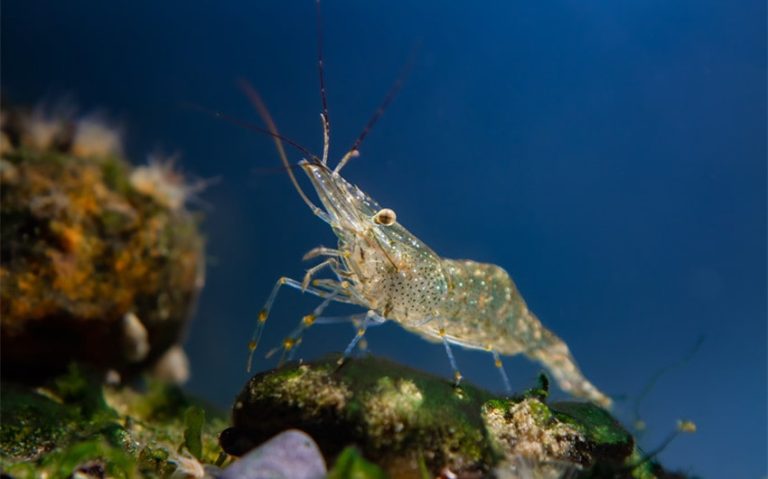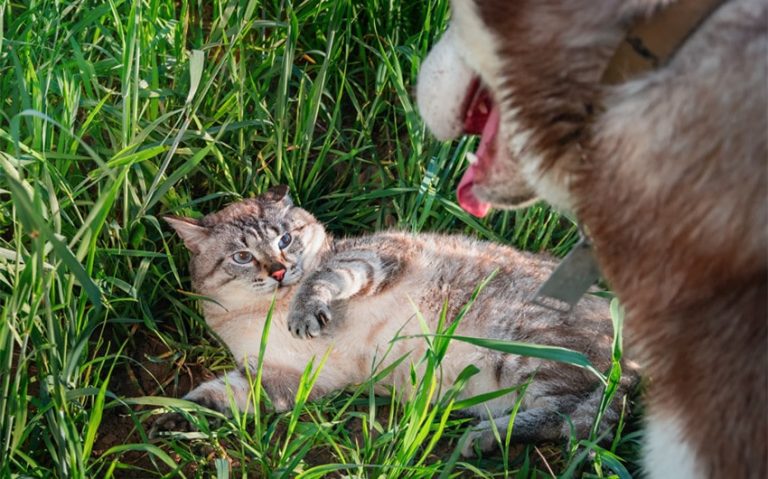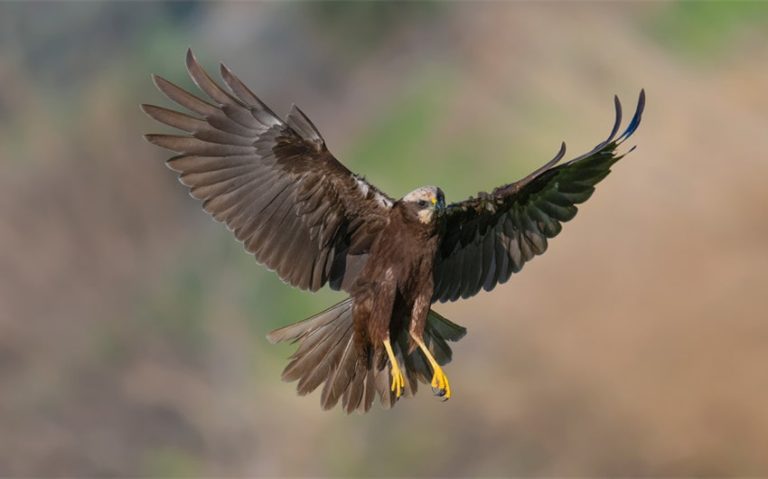What Do Peacocks Eat? A Complete Guide to Their Diet
Peacocks are known for their stunning, colorful feathers, but have you ever wondered what do peacocks eat to maintain their beauty and health? Whether they’re roaming wild or living in captivity, a balanced diet is key to their well-being. Peacocks enjoy a variety of foods, from fruits and seeds to insects and small animals.
Understanding what they eat not only helps them thrive but also ensures their vibrant feathers remain bright and healthy. Let’s dive into the details of a peacock’s diet and explore the best foods that keep these magnificent birds in top condition.
Natural Diet of Peacocks in the Wild
In the wild, peacocks have access to a diverse and varied diet that helps them thrive in their natural environments. As omnivores, peacocks are opportunistic feeders, meaning they eat both plant-based foods and small animals, depending on availability. This flexibility allows them to adapt to different habitats, including forests, grasslands, and farmlands. Let’s explore some of the main components of a peacock’s natural diet in the wild.
Fruits and Berries
Wild peacocks forage for a wide variety of fruits and berries that provide them with essential vitamins, minerals, and sugars. These natural sources of carbohydrates are important for maintaining their energy levels.
In tropical and subtropical regions where peafowl are commonly found, they feast on fruits such as figs, mangoes, guavas, and other native berries. The sweet and juicy nature of fruits makes them an attractive food source, and peacocks often eat fallen fruit directly off the ground, benefiting from nature’s seasonal offerings. This also helps them stay hydrated, especially during dry seasons when water sources may be limited.
Insects and Small Invertebrates
A critical part of a peacock’s diet in the wild is protein-rich insects and small invertebrates. Peacocks consume a variety of insects, including grasshoppers, ants, termites, beetles, and caterpillars. These small creatures provide essential proteins and fats that are crucial for muscle development, feather growth, and overall health. Insects also make up a significant portion of a peacock’s diet during the breeding season, as the extra protein helps support egg production and the rearing of young chicks.
Peacocks are skilled foragers and will often scratch the ground to uncover hidden insects. They also exhibit patience when hunting insects, waiting for the right moment to strike. This part of their diet ensures they maintain the necessary protein intake to support their active lifestyle and vibrant plumage.
Plants and Seeds
In addition to fruits and insects, wild peacocks consume a variety of plants and seeds. They forage for different types of grasses, leaves, and shoots, which provide them with essential fiber and nutrients. Peacocks may also peck at small seeds, grains, and legumes that they come across while foraging. Seeds are a great source of healthy fats and proteins, which help sustain the peacock’s energy throughout the day.
Some plants also offer medicinal benefits, helping peacocks naturally ward off parasites and infections. The diversity in their plant-based diet helps maintain their digestive health, contributing to their overall resilience in the wild.
Small Reptiles and Amphibians
While not the primary component of their diet, peacocks occasionally hunt and eat small reptiles and amphibians, such as lizards, frogs, and even small snakes. These creatures offer a rich source of protein and calcium, important for bone strength and the development of their elaborate feathers.
Peacocks have a keen eye for movement, and they may stalk small prey before swiftly catching and consuming it. This carnivorous aspect of their diet highlights their versatility as omnivores, able to survive on a range of food sources depending on availability.
Grains and Nuts
In some regions, wild peacocks are known to forage for grains and nuts that grow naturally or are left behind from human activities, such as farming. They will eat wheat, barley, millet, and other grains that they find in fields or rural areas. Nuts are another occasional food source that provides healthy fats, protein, and energy. Though not always abundant, grains and nuts supplement their diet, especially in areas near human settlements.
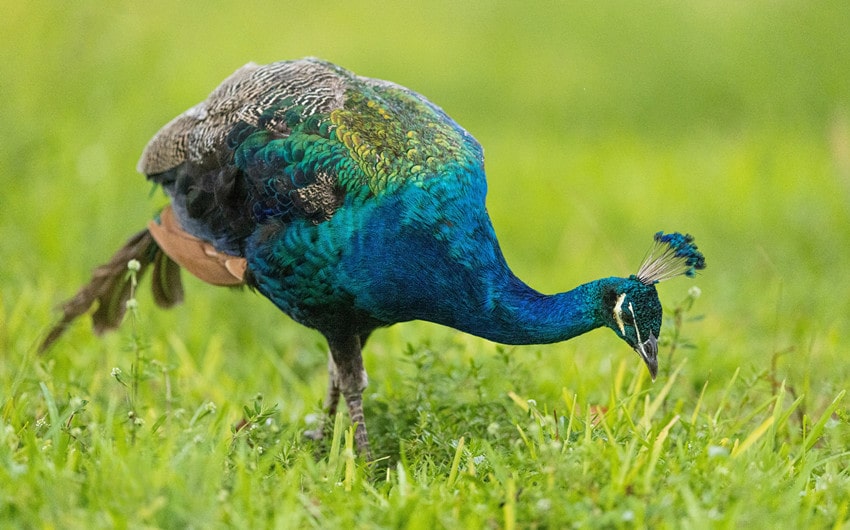
What Peacocks Eat in Captivity
In captivity, peacocks have different dietary needs compared to their wild counterparts. While they still require a variety of foods to stay healthy and vibrant, their diet is often more controlled and supplemented by human caretakers. Ensuring that peafowl get the proper balance of nutrients is crucial to maintaining their overall health, beautiful feathers, and ability to thrive in a captive environment. Let’s explore what peacocks typically eat in captivity and how their diet is managed.
Commercial Feed for Peafowl
One of the primary food sources for peacocks in captivity is specially formulated commercial feed. These feeds are designed to meet the nutritional requirements of peafowl and typically come in pellet or crumble form.
Commercial feed contains a balanced mix of grains, vitamins, minerals, and protein to ensure that the birds get all the essential nutrients they need. Many commercial feeds also contain specific ingredients that support feather health and growth, making them ideal for peafowl, whose vibrant plumage is a key aspect of their appearance.
In captivity, it’s important to choose a high-quality feed designed for game birds, poultry, or peafowl specifically, as these feeds provide the right blend of protein and nutrients. The protein content in their diet should be around 20-24%, particularly during the breeding season or when the birds are molting and growing new feathers. Commercial feed helps eliminate any guesswork and ensures that peacocks are receiving a well-rounded diet, even if they aren’t able to forage for food as they would in the wild.
Fruits and Vegetables
To mimic the variety found in their natural diet, captive peacocks are often fed fresh fruits and vegetables. These provide essential vitamins, minerals, and hydration, keeping the birds healthy and supporting their immune system. Common fruits offered to peafowl in captivity include apples, pears, grapes, melons, and berries. Peacocks enjoy sweet fruits, and these make for nutritious treats that help replicate their wild foraging behavior.
In addition to fruits, peafowl are also fed a variety of vegetables such as spinach, lettuce, kale, carrots, and peas. Leafy greens are particularly beneficial because they offer fiber, which supports digestion, and provide key vitamins like A and C. Adding fruits and vegetables to a peacock’s diet in captivity ensures they get a wide range of nutrients, just as they would in the wild, helping to keep them vibrant and strong.
Grains and Seeds
Grains and seeds form a significant part of a peacock’s diet in captivity, providing carbohydrates, proteins, and fats essential for their energy levels. Common grains fed to peafowl include wheat, barley, oats, and corn. These grains are often mixed with commercial feed or given separately to supplement their diet. Corn, in particular, is a popular choice because it is a rich source of energy and helps keep the birds warm in colder weather. However, it’s important to balance the amount of corn with other grains to prevent excess weight gain.
Seeds, such as sunflower seeds and millet, are another favorite among peafowl. They not only provide healthy fats but also encourage natural foraging behavior, as peacocks enjoy pecking and scratching for seeds. Offering a mix of grains and seeds in captivity helps simulate the variety they would experience in the wild and ensures they get the necessary nutrients to stay healthy.
Insects and Supplementary Protein
Even in captivity, peacocks benefit from protein-rich foods, particularly during breeding and molting seasons. While they may not be able to hunt insects and small creatures as they would in the wild, caretakers often provide supplementary protein sources like mealworms, crickets, or earthworms. These insects mimic the peacocks’ natural diet and are a favorite treat for captive birds.
For larger collections of peafowl, it’s common to see live or dried insects added to their diet to provide a natural source of protein and fats. This not only supports feather growth and overall health but also stimulates the birds mentally, as they can engage in foraging behaviors similar to those in the wild. In addition to insects, some peafowl keepers may add cooked eggs or small amounts of lean meat as supplementary protein sources, especially during times of increased energy demands.
Supplements and Additives
In captivity, peacocks may also require additional supplements to ensure they are receiving all the essential nutrients they would otherwise get from foraging. Calcium supplements are particularly important, especially for female peafowl during the breeding season, as they help with eggshell formation and support bone health. Oyster shells or ground limestone are often added to their feed as a natural calcium source.
Vitamins and minerals can also be provided through specially formulated additives mixed into their feed or water. These supplements help ensure that captive peafowl are getting all the nutrients necessary for their well-being, especially when their environment doesn’t provide the same variety as the wild. In particular, vitamin D is essential for their bone and feather health, especially if the birds don’t have regular access to sunlight.
Fresh Water
Like all animals, peacocks need access to clean, fresh water at all times. In captivity, it’s important to regularly change their water to ensure it remains free from dirt, bacteria, and contaminants. Water is essential for digestion, hydration, and overall health. It also helps keep their feathers in good condition, as proper hydration supports the natural oil production that keeps their plumage glossy and vibrant.
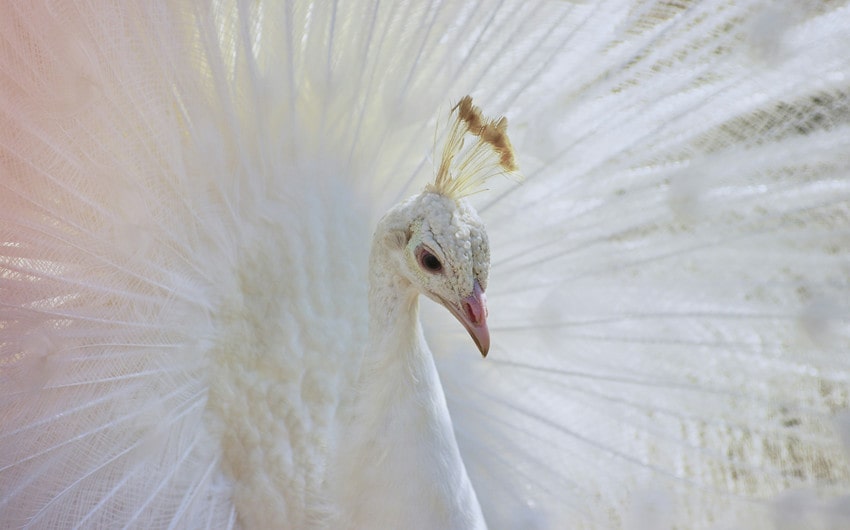
Foods to Avoid Feeding Peacocks
While peacocks can enjoy a varied and balanced diet, certain foods can be harmful or even dangerous to their health. It’s essential for peacock owners and caretakers to know which foods to avoid to ensure the birds remain healthy and free from harm.
Peafowl have sensitive digestive systems, and some foods can cause toxic reactions, nutritional imbalances, or digestive problems. Let’s explore the foods that should be kept away from peacocks, whether they are living in captivity or roaming freely in human-influenced environments.
Toxic Plants and Foods
Some plants and foods that are perfectly safe for humans or other animals can be toxic to peafowl. These foods can cause anything from mild digestive issues to more severe health problems, such as poisoning. Here are some of the common toxic plants and foods that should never be fed to peacocks:
- Avocado: Avocados contain persin, a compound that is toxic to many birds, including peafowl. Persin can cause heart and respiratory problems in peacocks, and consuming even a small amount of avocado could be fatal.
- Chocolate: Like many animals, peafowl are highly sensitive to theobromine, a chemical found in chocolate. Eating chocolate can lead to heart problems, seizures, and even death in birds. It’s important to avoid giving peafowl any chocolate-based products, even in small quantities.
- Caffeine: Caffeinated beverages like coffee, tea, or soda are dangerous for peafowl. Caffeine can overstimulate their nervous systems, causing heart problems, tremors, and digestive issues. Caretakers should ensure that peafowl never have access to caffeinated drinks or foods containing caffeine.
- Onions and Garlic: While small amounts of onion or garlic may not cause immediate harm, these foods contain compounds that can lead to anemia in peafowl if consumed regularly. Onions, in particular, contain sulfur compounds that can damage red blood cells in birds, leading to weakness and other health issues.
- Alcohol: Alcoholic beverages should be strictly avoided, as they can cause severe damage to a peacock’s liver and nervous system. Even small amounts of alcohol can be dangerous for birds, leading to intoxication, disorientation, and potentially fatal consequences.
- Rhubarb: Rhubarb leaves are toxic to many animals, including peafowl. They contain oxalic acid, which can cause kidney failure and other serious health issues. While the stalks of rhubarb are safe for humans, the leaves should be avoided in any area where peafowl might forage.
Processed and Salty Foods
Just as processed foods can be unhealthy for humans, they are even more detrimental to peafowl. These foods are often high in salt, sugars, and unhealthy fats, none of which are suitable for birds. Offering processed foods to peacocks can lead to nutritional imbalances and long-term health problems. Here are some specific examples of foods to avoid:
- Salty Snacks: Foods like potato chips, pretzels, and salted nuts contain excessive amounts of salt, which can lead to dehydration and kidney damage in peafowl. Birds are particularly sensitive to high sodium levels, so it’s important to avoid giving them salty snacks.
- Sugary Foods: Sugary treats such as candy, cakes, cookies, and sugary cereals are not appropriate for peafowl. Excessive sugar intake can lead to obesity, diabetes, and other metabolic issues. Peafowl thrive on natural sugars found in fruits, not artificial or processed sugars found in human snacks.
- Fried or Greasy Foods: Foods that are high in unhealthy fats, such as fried foods, can cause digestive problems in peafowl. These foods are difficult for birds to process and can lead to weight gain, clogged arteries, and fatty liver disease. It’s best to stick to natural, wholesome foods when feeding peafowl.
- Bread and Other Empty Carbohydrates: Bread, while often fed to birds by humans, is not an ideal food for peafowl. It lacks the essential nutrients that peafowl need, and consuming too much bread can fill them up without providing proper nourishment. Over time, a diet that includes too much bread can lead to malnutrition and other health problems.
Dairy Products
Peafowl, like most birds, are lactose intolerant, meaning they cannot properly digest lactose found in dairy products. Feeding peafowl dairy items such as milk, cheese, or yogurt can lead to digestive distress, including diarrhea and bloating. Birds do not naturally consume dairy in the wild, and their digestive systems are not equipped to handle it. Avoid offering any dairy products to peafowl, as it can cause more harm than good.
Raw or Undercooked Meat
While peafowl do consume insects and small animals as part of their natural diet, feeding them raw or undercooked meat from human sources is risky. Raw meat, especially poultry or pork, can contain harmful bacteria like Salmonella or E. coli, which can make peafowl sick. Additionally, raw meat can introduce parasites to peafowl that would not normally be present in their natural diet.
If protein needs to be supplemented in their diet, it’s best to offer cooked eggs, lean cooked meats, or commercially prepared dried insects like mealworms. These protein sources are safer and can help mimic the peacock’s natural foraging behavior without the risks associated with raw meat.
Moldy or Spoiled Foods
It’s essential to avoid feeding peafowl any moldy, spoiled, or rotten foods. Mold can produce toxins called mycotoxins, which are harmful to birds and can lead to a variety of health problems, including respiratory issues, digestive distress, and even death. Always ensure that the food provided to peafowl is fresh and free from mold or spoilage. This includes checking grains, fruits, and vegetables regularly for signs of decay.
Human Snacks and Junk Food
While it can be tempting to share human snacks with peafowl, it’s important to resist the urge. Junk foods like chips, cookies, and candy are not only devoid of nutritional value but can also be harmful to birds. The high levels of salt, sugar, and artificial ingredients in these foods can cause serious health issues over time, leading to obesity, metabolic disorders, and weakened immune systems.
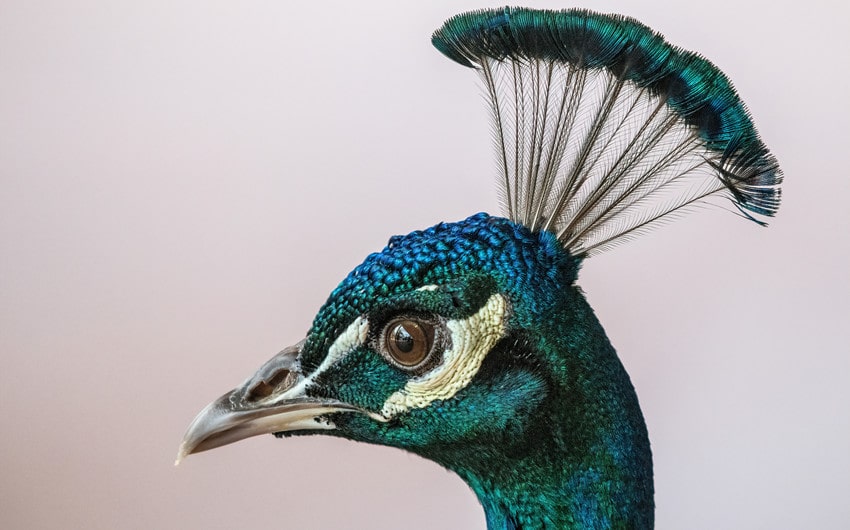
How Diet Impacts Peacock Health and Feathers
A peacock’s diet plays a crucial role in its overall health, vitality, and, perhaps most notably, its vibrant, eye-catching feathers. These majestic birds are admired for their striking plumage, especially the males, whose iridescent tail feathers are a symbol of beauty and elegance.
The health of a peacock’s feathers is directly linked to the quality of its diet, and providing the right nutrients is essential to maintaining not only the bird’s outward appearance but also its internal well-being. Let’s explore how diet impacts a peacock’s health and the condition of its feathers, and what specific nutrients are required for optimal feather growth and vibrancy.
Nutritional Balance and Feather Quality
Peacocks are known for their spectacular plumage, which serves as a key aspect of their mating rituals and overall identity. The brilliant blues, greens, and metallic shades in their feathers are a result of both genetics and proper nutrition. A well-balanced diet that includes the right amounts of protein, vitamins, minerals, and healthy fats is essential for the growth and maintenance of these feathers.
Proteins, in particular, are vital for feather development, as feathers are made primarily of keratin, a protein. When a peacock’s diet lacks sufficient protein, it may lead to poor feather quality, dull coloration, and slow regrowth after molting. This is especially critical during the molting season when peacocks shed old feathers and grow new ones. A protein-rich diet helps ensure that feathers grow back strong, vibrant, and resilient.
In addition to protein, a peacock’s diet needs to include essential vitamins like A, D, and E, which support overall feather health. Vitamin A helps with feather pigmentation and immune system function, while vitamin D promotes healthy bones and feather structure. Vitamin E acts as an antioxidant, protecting the bird from cellular damage and promoting healthy skin, which in turn supports feather quality.
Color Enhancement Through Diet
The stunning, iridescent colors of a peacock’s feathers are not only a result of their genetic makeup but are also influenced by the nutrients they consume. Certain pigments found in their diet can enhance the vibrancy of their feathers.
For example, carotenoids, which are naturally occurring pigments found in fruits, vegetables, and seeds, can intensify the richness of the colors in a peacock’s plumage. Foods like carrots, sweet potatoes, corn, and leafy greens are rich in carotenoids and can boost the peacock’s vibrant appearance.
In the wild, peacocks forage for a wide variety of foods that naturally provide these pigments. In captivity, it’s important to ensure their diet includes similar nutrient-rich foods to maintain their signature coloration. A diet lacking in these essential nutrients may result in dull, lackluster feathers, making it difficult for male peacocks to attract mates and fully display their beauty.
In addition to carotenoids, other natural pigments in foods can enhance the hues in a peacock’s feathers. For instance, fruits like blueberries, blackberries, and grapes contain antioxidants and pigments that support a healthy and colorful feather display. Caretakers in captivity often add a variety of colorful fruits and vegetables to the peacock’s diet to replicate the diversity of nutrients they would get in the wild.
Feather Molting and Regrowth
Molting is a natural process for all birds, including peacocks, where they shed old, damaged feathers to make way for new growth. This process occurs annually, usually after the breeding season, and it requires significant nutritional support. During molting, peacocks rely heavily on proteins, vitamins, and minerals to ensure that their new feathers grow back strong and healthy.
Feathers are primarily made of keratin, and during molting, peacocks experience an increased demand for protein in their diet to support keratin production. A protein-deficient diet during this time can lead to weak, brittle feathers that may break easily or not achieve their full size and vibrancy. Providing high-quality protein sources like insects, mealworms, and protein-rich grains can help support the rapid feather regeneration that occurs during molting.
Calcium is another essential mineral during the molting process. It helps with the formation of strong feather shafts, which are necessary for maintaining the structure and durability of the feathers. Additionally, vitamins like biotin (a B-vitamin) and minerals like zinc support healthy feather growth and help prevent issues like feather loss or abnormal feather growth patterns.
Caretakers need to pay special attention to a peacock’s diet during the molting season to ensure that it has enough nutrients to complete the molting process successfully. This period can be stressful for the bird, and providing a nutrient-rich diet will help minimize stress and promote faster, healthier feather regrowth.
Immune System and Disease Prevention
A well-balanced diet does more than just enhance a peacock’s physical appearance—it plays a critical role in supporting the bird’s immune system and overall health. Peacocks that receive a diet rich in vitamins, minerals, and antioxidants are better equipped to fight off infections, diseases, and parasites. A healthy immune system helps prevent common issues like feather mites, which can damage feathers and affect their appearance.
Vitamins A and E are particularly important for immune health. Vitamin A supports the health of the bird’s skin and mucous membranes, which are the first line of defense against infections. Vitamin E, an antioxidant, helps neutralize harmful free radicals in the body, reducing the risk of illness and ensuring that the peacock’s feathers remain vibrant and undamaged.
In captivity, peacocks may be more susceptible to diseases due to close confinement and limited access to the variety of foods they would forage for in the wild. Supplementing their diet with immune-boosting foods like leafy greens, fruits, and grains helps support their natural defenses and keeps them healthy, allowing them to maintain their feathers in optimal condition.
Energy Levels and Physical Vitality
Peacocks are active birds that require plenty of energy to move, forage, and display their feathers, especially during courtship displays. A peacock’s diet needs to provide enough calories from carbohydrates, proteins, and healthy fats to sustain their energy levels throughout the day. Grains like corn, wheat, and barley provide peafowl with a rich source of carbohydrates, while seeds and nuts contribute healthy fats that fuel their activities.
A diet that lacks sufficient energy can lead to lethargy, weight loss, and poor feather condition. Peacocks that are not getting enough calories may be unable to engage in their normal behaviors, including courtship displays, which are crucial for their reproductive success. Ensuring that their diet contains a good mix of energy-rich foods will keep them active, healthy, and able to showcase their feathers to full effect.


